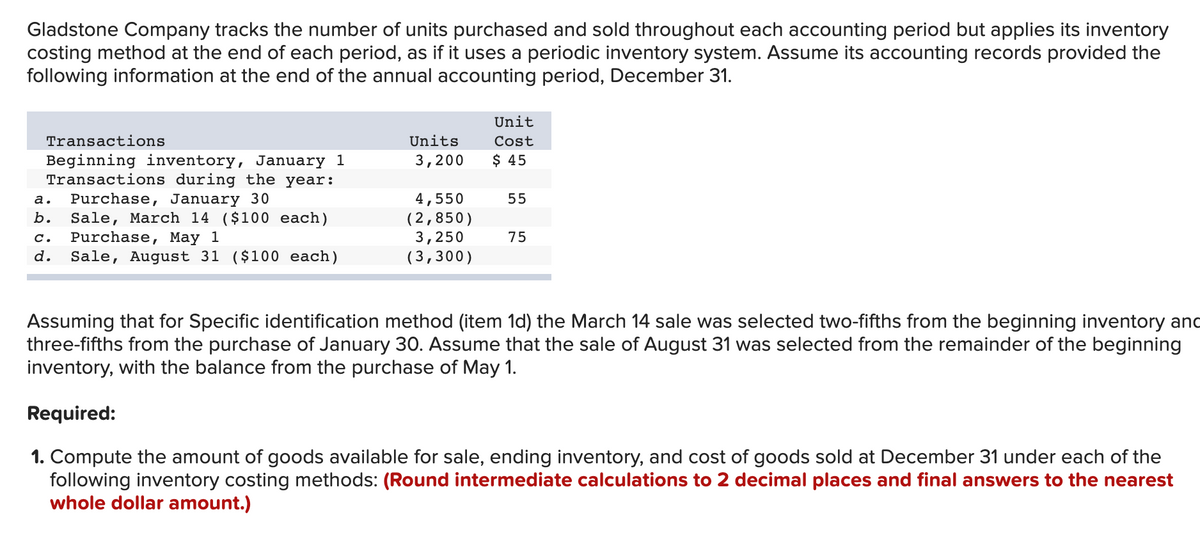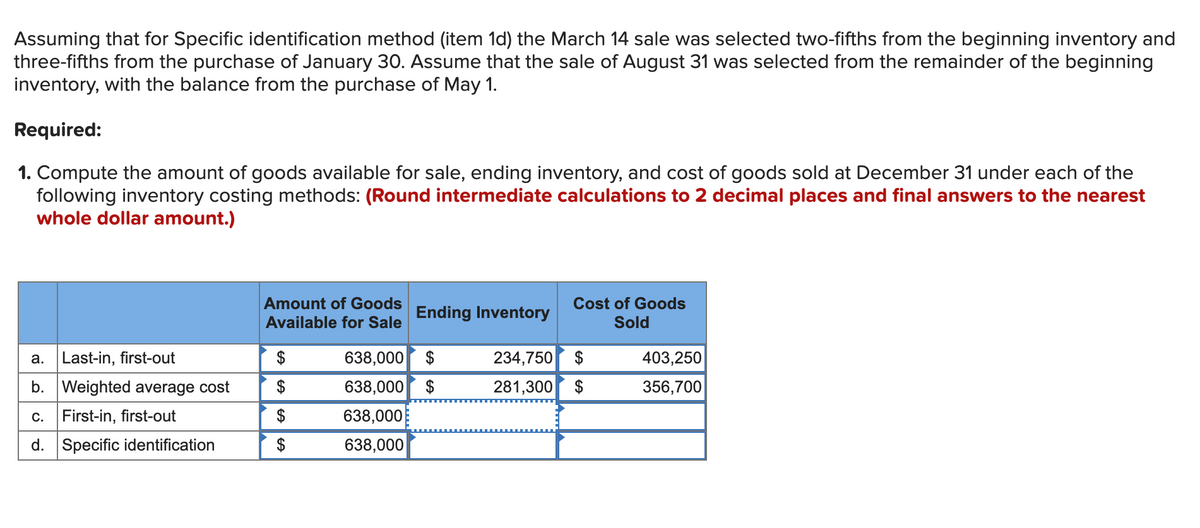Gladstone Company tracks the number of units purchased and sold throughout each accounting period but applies its inventory costing method at the end of each period, as if it uses a periodic inventory system. Assume its accounting records provided the following information at the end of the annual accounting period, December 31. Unit Transactions Units Cost $ 45 Beginning inventory, January 1 Transactions during the year: a. Purchase, January 30 b. Sale, March 14 ($100 each) Purchase, May 1 d. Sale, August 31 ($100 each) 3,200 4,550 (2,850) 3,250 (3,300) 55 c. 75 Assuming that for Specific identification method (item 1d) the March 14 sale was selected two-fifths from the beginning inventory ai three-fifths from the purchase of January 30. Assume that the sale of August 31 was selected from the remainder of the beginning inventory, with the balance from the purchase of May 1. Required: 1. Compute the amount of goods available for sale, ending inventory, and cost of goods sold at December 31 under each of the following inventory costing methods: (Round intermediate calculations to 2 decimal places and final answers to the nearest whole dollar amount.)
Gladstone Company tracks the number of units purchased and sold throughout each accounting period but applies its inventory costing method at the end of each period, as if it uses a periodic inventory system. Assume its accounting records provided the following information at the end of the annual accounting period, December 31. Unit Transactions Units Cost $ 45 Beginning inventory, January 1 Transactions during the year: a. Purchase, January 30 b. Sale, March 14 ($100 each) Purchase, May 1 d. Sale, August 31 ($100 each) 3,200 4,550 (2,850) 3,250 (3,300) 55 c. 75 Assuming that for Specific identification method (item 1d) the March 14 sale was selected two-fifths from the beginning inventory ai three-fifths from the purchase of January 30. Assume that the sale of August 31 was selected from the remainder of the beginning inventory, with the balance from the purchase of May 1. Required: 1. Compute the amount of goods available for sale, ending inventory, and cost of goods sold at December 31 under each of the following inventory costing methods: (Round intermediate calculations to 2 decimal places and final answers to the nearest whole dollar amount.)
Financial Accounting
15th Edition
ISBN:9781337272124
Author:Carl Warren, James M. Reeve, Jonathan Duchac
Publisher:Carl Warren, James M. Reeve, Jonathan Duchac
Chapter6: Accounting For Merchandising Businesses
Section: Chapter Questions
Problem 9PA: On December 31, 2019, the balances of the accounts appearing in the ledger of Wyman Company are as...
Related questions
Topic Video
Question
100%
Gladstone Company tracks the number of units purchased and sold throughout each accounting period but applies its inventory costing method at the end of each period as if it uses a periodic inventory system. Assume its accounting records provided the following information at the end of the annual accounting period, December 31.
| Transactions | Units | Unit Cost | |||||
| Beginning inventory, January 1 | 3,200 | $ | 45 | ||||
| Transactions during the year: | |||||||
| a. | Purchase, January 30 | 4,550 | 55 | ||||
| b. | Sale, March 14 ($100 each) | (2,850 | ) | ||||
| c. | Purchase, May 1 | 3,250 | 75 | ||||
| d. | Sale, August 31 ($100 each) | (3,300 | ) | ||||
Assuming that for the Specific identification method (item 1d) the March 14 sale was selected two-fifths from the beginning inventory and three-fifths from the purchase of January 30. Assume that the sale of August 31 was selected from the remainder of the beginning inventory, with the balance from the purchase of May 1.

Transcribed Image Text:Gladstone Company tracks the number of units purchased and sold throughout each accounting period but applies its inventory
costing method at the end of each period, as if it uses a periodic inventory system. Assume its accounting records provided the
following information at the end of the annual accounting period, December 31.
Unit
Transactions
Units
Cost
$ 45
Beginning inventory, January 1
Transactions during the year:
Purchase, January 30
Sale, March 14 ($100 each)
Purchase, May 1
Sale, August 31 ($100 each)
3,200
4,550
(2,850)
3,250
(3,300)
а.
55
b.
с.
75
d.
Assuming that for Specific identification method (item 1d) the March 14 sale was selected two-fifths from the beginning inventory and
three-fifths from the purchase of January 30. Assume that the sale of August 31 was selected from the remainder of the beginning
inventory, with the balance from the purchase of May 1.
Required:
1. Compute the amount of goods available for sale, ending inventory, and cost of goods sold at December 31 under each of the
following inventory costing methods: (Round intermediate calculations to 2 decimal places and final answers to the nearest
whole dollar amount.)

Transcribed Image Text:Assuming that for Specific identification method (item 1d) the March 14 sale was selected two-fifths from the beginning inventory and
three-fifths from the purchase of January 30. Assume that the sale of August 31 was selected from the remainder of the beginning
inventory, with the balance from the purchase of May 1.
Required:
1. Compute the amount of goods available for sale, ending inventory, and cost of goods sold at December 31 under each of the
following inventory costing methods: (Round intermediate calculations to 2 decimal places and final answers to the nearest
whole dollar amount.)
Amount of Goods
Cost of Goods
Ending Inventory
Available for Sale
Sold
638,000 $
638,000 $
Last-in, first-out
$
234,750 $
403,250
a.
b. Weighted average cost
$
281,300 $
356,700
c. First-in, first-out
$
638,000
d. Specific identification
$
638,000
Expert Solution
This question has been solved!
Explore an expertly crafted, step-by-step solution for a thorough understanding of key concepts.
This is a popular solution!
Trending now
This is a popular solution!
Step by step
Solved in 2 steps

Knowledge Booster
Learn more about
Need a deep-dive on the concept behind this application? Look no further. Learn more about this topic, accounting and related others by exploring similar questions and additional content below.Recommended textbooks for you

Financial Accounting
Accounting
ISBN:
9781337272124
Author:
Carl Warren, James M. Reeve, Jonathan Duchac
Publisher:
Cengage Learning


College Accounting, Chapters 1-27
Accounting
ISBN:
9781337794756
Author:
HEINTZ, James A.
Publisher:
Cengage Learning,

Financial Accounting
Accounting
ISBN:
9781337272124
Author:
Carl Warren, James M. Reeve, Jonathan Duchac
Publisher:
Cengage Learning


College Accounting, Chapters 1-27
Accounting
ISBN:
9781337794756
Author:
HEINTZ, James A.
Publisher:
Cengage Learning,

Intermediate Accounting: Reporting And Analysis
Accounting
ISBN:
9781337788281
Author:
James M. Wahlen, Jefferson P. Jones, Donald Pagach
Publisher:
Cengage Learning

Financial And Managerial Accounting
Accounting
ISBN:
9781337902663
Author:
WARREN, Carl S.
Publisher:
Cengage Learning,

College Accounting (Book Only): A Career Approach
Accounting
ISBN:
9781337280570
Author:
Scott, Cathy J.
Publisher:
South-Western College Pub